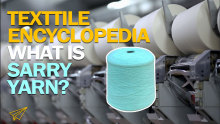Sweater Manufacturing | Textile Manufacturing
There are many types of fabrics. According to different manufacturing methods, they can be divided into woven fabrics and knitted fabrics, etc.
 Audited supplier
Audited supplierThere are many types of fabrics. According to different manufacturing methods, they can be divided into woven fabrics and knitted fabrics, etc.

The woven fabric consists of warp and weft on the loom. Yarns or threads are interwoven according to a certain rule, usually referred to as weaving. While knitting is formed by the loops of the yarn being bent into each other regularly. Knitted fabrics are divided into two categories: warp knitted fabrics and weft knitted fabrics.

In weft knitting, the loops move in the horizontal direction, while in warp knitting, the yarn is converted into loops in the vertical direction. Most of the sweaters we see are weft knitted fabrics.

So, let's take a look at the sweater manufacturing process.
#1: Yarn Inspection

Let's head over to the yarn inspection process. Several parameters need to be detected in this process, including the yarn linear density deviation, evenness, moisture regain, and color fastness and so on. These parameters will directly affect the quality of the product.
#2: Construction

This process can be understood as design & programming. The construction man will upload the program that bases on the yarn materials properties and the final clothes product desired properties.
#3: Knitting Sample

Before mass production, knitting a sample piece is an essential step. If the knitted sample does not meet the requirements, for example, over elastic, then it is likely that there are some problems between the yarn specification and the program of the loom, so that the construction needs to be redone.
#4: Knitting Piece
 After uploading the program, the loom will automatically knit pieces according to our setting. Typically, loom knitting is the same principle as hand knitting.
After uploading the program, the loom will automatically knit pieces according to our setting. Typically, loom knitting is the same principle as hand knitting.
#5: Checking Piece
 When a piece finishes knitting, the workers will collect it with others, and check if there are any incorrections on color, shape or somethings. Those pieces that seem to meet the requirements will be sent to the next department for the next process.
When a piece finishes knitting, the workers will collect it with others, and check if there are any incorrections on color, shape or somethings. Those pieces that seem to meet the requirements will be sent to the next department for the next process.
#6: Linking
 In this process, the work to do is to link together the pieces for different parts of a sweater by the sewing tray. The sewing tray is sewing equipment whose main function is to sew the panels together. After this process, the pieces merge and become a semi-finished product.
In this process, the work to do is to link together the pieces for different parts of a sweater by the sewing tray. The sewing tray is sewing equipment whose main function is to sew the panels together. After this process, the pieces merge and become a semi-finished product.
#7: Hand Stitching
 There are many parts of the sweater that the machine cannot sew, and there will be extra stitches and thread ends exposed, which needs to be manually cut off. And the excess yarns other than sutures need to be removed by hand. These kinds of work are called hand stitching.
There are many parts of the sweater that the machine cannot sew, and there will be extra stitches and thread ends exposed, which needs to be manually cut off. And the excess yarns other than sutures need to be removed by hand. These kinds of work are called hand stitching.
#8: Dyeing
 If a factory is going to produce a solid color sweater, then it probably uses the raw white yarns for knitting. If this is the case, it must contain this dyeing process to dye a specific solid color.
If a factory is going to produce a solid color sweater, then it probably uses the raw white yarns for knitting. If this is the case, it must contain this dyeing process to dye a specific solid color.
#9: Washing
 Here, the washing process is not the same as daily laundry, cause some additives will be added in for the following purposes: removing stains and peculiar smell, getting good hand feeling, fastening color, and adjusting shrinkage. The washing process occupies a very important position in the sweater manufacturing process because the hand feeling of sweaters is mostly controlled by this process.
Here, the washing process is not the same as daily laundry, cause some additives will be added in for the following purposes: removing stains and peculiar smell, getting good hand feeling, fastening color, and adjusting shrinkage. The washing process occupies a very important position in the sweater manufacturing process because the hand feeling of sweaters is mostly controlled by this process.
#10: Ironing
 The purpose of ironing is to shape the product, maintain the style characteristics, have a flat appearance, and have a comfortable hand feeling. The shaping temperature of the sweater is generally 120℃(248℉)~180℃(356℉).
The purpose of ironing is to shape the product, maintain the style characteristics, have a flat appearance, and have a comfortable hand feeling. The shaping temperature of the sweater is generally 120℃(248℉)~180℃(356℉).
#11: Labelling
 This process is to sew the customer's label on sweaters.
This process is to sew the customer's label on sweaters.
#12: Inspecting
 The workers will carefully inspect and remove the stains and extra thread somethings.
The workers will carefully inspect and remove the stains and extra thread somethings.
#13: Mending
 If there are any seams or holes on the sweater, then the workers will mend it.
If there are any seams or holes on the sweater, then the workers will mend it.
#14: QC
 The QC team needs to make sure that the yarn material in the sweater is correct, and that there is no color difference in a sweater, and that the sweater's appearance is flat and tidy.
The QC team needs to make sure that the yarn material in the sweater is correct, and that there is no color difference in a sweater, and that the sweater's appearance is flat and tidy.
#15: Packing
 After all other processes, the final sweater products are going to be perfect logically. And they will be packed up and sent to the customers.
After all other processes, the final sweater products are going to be perfect logically. And they will be packed up and sent to the customers.
Tittle
 Audited supplier
Audited supplier
Polyester Yarn Manufacturing Process | From Chips to Cone Yarn

Polyester Yarn vs Nylon Yarn | Yarn Properties

70D Nylon DTY Twisted

What is Dope Dyed Yarn? - Textile Encyclopedia - Salud Yarn

What is Semi-Dull Yarn? - Textile Encyclopedia - Salud Yarn

What is Sarry Yarn? - Textile Encyclopedia - Salud Yarn

What is Cotton Yarn? - Textile Encyclopedia - Salud Yarn

What is Tex of Yarn Count? - Textile Encyclopedia - Salud Yarn

What is Denier of Yarn Count? - Textile Encyclopedia - Salud Yarn








